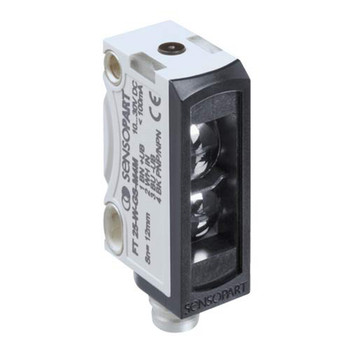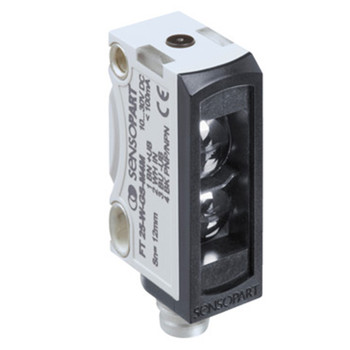Contrast Sensor
contrast sensor- to detect the difference between two colors
Contrast is the difference in opposites, such as black and white. In photoelectric sensors, contrast is the difference in brightness between two objects or in multiple colors on an object. As a result, the larger the difference, the higher the contrast.
A contrast sensor is a high-efficiency photoelectric sensor that detects the difference between two colors. These colors are usually used in symbols and backgrounds.
Contrast sensors feature either switching or analog output. The sensor with switching output evaluates the detection process, brightness, or light level from the sample presented to the sensor. For each new sample presented, the sensor compares the value of the new sample with the trained one to determine whether it is more similar to the signal or the background. On the other hand, Sensors with analog output provide the measured brightness as a proportional voltage signal to monitor brightness curves.
Most contrast sensors use a color-changing LED that detects minimal contrasts for better performance. The color of the emitted light is automatically selected based on the sensor conditions. Industrial applications include packaging, beverage and bottling, paper and printing machinery, and ceramics printing.
Here we offer you different kinds of contrast sensors from Sensopart, a well-known brand for photoelectric sensors. You may be interested in the contrast sensor price or may even have technical questions. Either way, contact us. Our technical experts are ready to help: +9714337738
Curious to know more about a Contrast Sensor ? The below blog post is just what you need:
Contrast Sensor [How It Works, Adjusting, Features and Applications]
-

Contrast Sensor 15 mm Sensing Distance, Push-pull Switching Output - FT 25-RGB1-GSL-M4M
Sensopart
Contrast Sensor 15 mm Sensing Distance, Push-pull Switching Output - FT 25-RGB1-GSL-M4M Precise and robust contrast sensor for detecting the slightest of contrast differences through multi-color RGB evaluation. The SensoPart FT 25-RGB Contrast Sensor... -

Contrast Sensor 150mm Sensing Distance, PNP/NPN Switching Output FT 55-CM-4-PNSD-L8M
Sensopart
This product uses connection of Plug M12 8-pin has switching output of I/O Link. This product gives Stable processes due to intelligent color detection, regardless of distance and also make sure the provision of Economical... -

Contrast Sensor 14.5mm Sensing Distance, Push-Pull Switching Output - FT 25-W2-GSL-M4
Sensopart
This product uses connection of Plug M8 4-pin has switching output of IO-Link. This product provides accurate detection of most minimal contrast levels. Through this product, one can undergo Reliable operation even with fluttering and... -

Contrast Sensor 15mm Sensing Distance, Push-Pull Switching Output - FT 25-RGB1-GSL-KL4
Sensopart
This product uses connection of Pigtail connector M12 4-pin has switching output of IO-Link. This product provides accurate detection of most minimal contrast levels because of Multi-Color-RGB-Evaluation. Through this...
